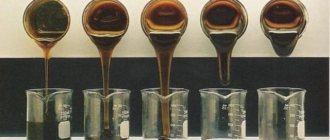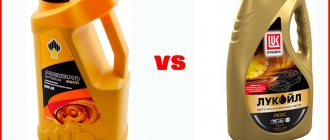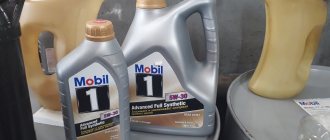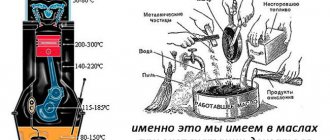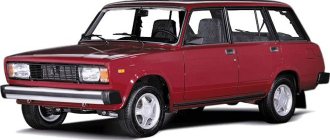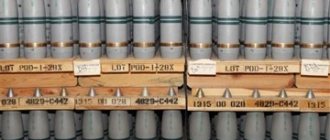Classification
- All engine oil is divided into three main groups based on the basis:
- synthetic
. This type of engine oil is labeled “Fully Synthetic” on the can (box). The basis is made up of chemicals synthesized through chemical processes. Combines well with various additives that improve the composition of the product. Has properties for protecting/cleaning internal combustion engines. Synthetic engine oil does not thicken at low temperatures (within the specified limits). Retains working properties even when exposed to high temperatures; - semi-synthetic
(“Semi-Synthetic”). A kind of compromise between mineral water and synthetics. However, the base is mineral, with a large number of additives. This composition is similar to a synthetic one, hence similar performance indicators at a lower price; - mineral
(“Mineral”). Mineral base is a product obtained during the distillation of oil. Technical and operational characteristics are inferior to synthetics. Operation at high temperatures is unstable due to the presence of natural components in its composition. At negative temperatures it thickens. Interacts with air during chemical reactions, which causes slag to form on the engine when boiling; - Motor oil is divided and classified according to the types of power units:
- gasoline engines;
- diesel;
- turbocharged.
- Viscosity-temperature property;
- Price.
Rating of motor oils for cars
The table below shows the TOP 5 best motor oils.
| № | Name | Type | Engine | Viscosity grade | Price |
| 5 | Lukoil | Synthetic | Diesel, petrol | 5W-40 | 590 |
| 4 | Liqui Moly | Synthetic | Diesel, petrol | 5W-40 | 927 |
| 3 | Mobile | Synthetic | Diesel, petrol | 5W-40 | 1250 |
| 2 | Shell Helix | Synthetic | Diesel, petrol | 5W-40 | 830 |
| 1 | Castrol | Synthetic | Diesel, petrol | 5W-40 | 1800 |
Lukoil
Domestic lubricant. Widely used. It can be used in Renault and Fiat foreign cars. The main advantage is the low price and the ability to work at -44°C. Disadvantages - contamination by by-products, high content of sulfur and oxides - not environmentally friendly.
Mobile
This brand of working fluid cleans the engine well. The replacement interval is quite long. It works well at any temperature and is resistant to weather changes. Another plus is the affordable cost of the product. Disadvantages: aggressive cleaning of the engine; counterfeit products are encountered.
Liqui Moly
Not a bad product, but the cost is high. The consumption is less. Provides excellent wear protection. The lubricant is popular among owners of sports cars and luxury cars. Disadvantage: Not suitable for all cars.
Shell Helix
Synthetic all-season lubricant. Perfectly protects engine operating components from corrosion and salt deposits, increases their wear resistance, and keeps parts clean. Can be poured into modern engines of any vehicle models. Disadvantages - you come across counterfeit products, the engine sometimes does not start in the cold.
Castrol
The most popular line of lubricating fluids in the Russian Federation is Castrol-Mahnatec. Perfectly suits the climatic conditions of Russia. Due to the increased sulfur content in Russian fuel, more oxidizing substances are added to the liquid. Oil can be poured into new domestic and foreign car models. Disadvantages include extraneous noise and excessive oil consumption during operation.
If a car owner is in doubt about which lubricant to use for the engine, he needs to learn more about the brands of motor oils, their types, applications, read the rating, read customer reviews and technical specifications.
Difference by application
The classification by area of application outlined above has 3 types (diesel, gasoline, turbocharged).
However, the recent trend has led to the emergence of a subgroup of its own types of oils. This is due to the mass production of turbocharged engines (gasoline, diesel).
This classification of engine oil distinguishes between formulations that use different additives. They create conditions for efficient oil operation on engines with a certain type of fuel. These additives prevent thickening and foaming of the oil composition in turbo engines. The corresponding indicator is indicated in the regulations of the international API standard (developed in 1947 by the American Petroleum Institute).
Two Latin letters after the name of the standard indicate the oil for a specific type of engine:
- letter S (“Service”) – gasoline engines;
- C (“Commercial”) – diesel.
The second letter after the data is responsible for the presence of a turbine, and also indicates the period of time for the production of power units - the oil is intended for them.
Diesel oils also contain the number 2 or 4, indicating a two/four-stroke engine.
Universal motor oil is used for gasoline and diesel - the classification in this situation has a double standard. Example: SF/CC, SG/CD and so on.
Explanations API (gasoline)
Classification according to the API standard with a few explanations:
Gasoline car engines:
- SC - development of cars (engines) until 1964;
- SD - until 1964-68;
- SE - until 1969-72;
- SF - until 1973-88;
- SG - until 1989-94 (severe operating conditions);
- SH—until 1995-96 (severe operating conditions);
- SJ - until 1997-2000 (modernized energy-saving properties);
- SL - until 2001-03 (long service life);
- SM - cars (motors) since 2004;
- SL+: enhanced resistance to oxidation.
Before pouring another brand of oil into the engine, you should know: the API indicator is used exclusively on an increasing basis. It is not recommended to change the class beyond two levels.
Example: SH motor oil was previously used, then the next brand will be SJ, because the oil composition of a higher class is enriched with all the additives of the previous one.
Not recommended: replacing the used oil composition marked SD (cars with archaic internal combustion engines) with SL (modern cars). This is fraught with malfunctions (increased wear) of engine parts.
API Explanations (Diesel)
Classification for diesel power plants:
- CB - machines (motors) designed before 1961 (high sulfur concentration);
- CC - until 1983 (severe operating conditions);
- CD - before 1990 (fuel contains large quantities of H2SO4; harsh operating conditions);
- CE - until 1990 (turbocharged);
- CF - before/from 90, (turbocharging);
- CG-4 - before/from '94 (turbocharged);
- CH-4 - before/from 98 (high standards for emissions of harmful substances into the atmosphere; for the US market);
- CI-4 - cars (power units) with turbocharging, with an EGR valve;
- CI-4+ (plus) - identical to the previous one (+ adaptation to high US environmental standards).
API classification of gear oils by performance level
The API classification by performance properties provides for the division of oils into 6 groups depending on the application, which is determined by the type of gear transmission, specific contact loads in the meshing zones and operating temperature.
| API Team | Group according to GOST | Properties and scope |
| GL-1 | TM-1 | Mineral oils without additives or with anti-oxidation and anti-foam additives without extreme pressure components for use, among other things, in manual gearboxes with low specific pressures and sliding speeds. Spur, worm and spiral bevel gears operating at low speeds and loads. |
| GL-2 | TM-2 | Worm gears operating in GL-1 conditions at low speeds and loads, but with higher requirements for anti-friction properties. May contain an anti-friction component. |
| Gl-3 | TM-3 | Transmission oils with a high content of additives with a performance level of MIL-L-2105. These oils are used preferably in manual transmissions and steering gears, final drives and low displacement hypoid gears in automobiles and off-road vehicles for the transport of goods, passengers and for non-transport applications. Spiral bevel gears operating in moderately harsh conditions. Conventional helical bevel gear transmissions operating under moderately severe speed and load conditions. They have better anti-wear properties than GL-2. |
| GL-4 | TM-4 | Transmission oils with a high content of additives with a performance level of MIL-L-2105. These oils are used preferably in manual transmissions and steering gears, final drives and low displacement hypoid gears in automobiles and off-road vehicles for the carriage of goods and passengers and for non-transport applications. Hypoid gears operating at high speeds with low torques and low speeds with high torques. Highly effective extreme pressure additives are required |
| GL-5 | TM-5 | Oils for hypoid gears with performance level MIL-L-2105 C/D. These oils are preferably used in hypoid bevel gears and circular bevel gears for final drives in automobiles and in motorcycle driveshafts and motorcycle step transmissions. Especially for hypoid gears with high axle displacement. For the most severe operating conditions with shock and alternating loads. Hypoid gears operating at high speeds with low torques and shock loads on gear teeth. Must have a large amount of sulfur-phosphorus containing extreme pressure additive |
| GL-6 | TM-6 | High displacement hypoid gears for high speed, high torque and shock load applications. They have more sulfur-phosphorus-containing extreme pressure additives than GL-5 oils. |
The GL-6 group is currently practically not used.
If necessary, the scope of application of the GL-5 group is supplemented with relevant information in the technical documentation for these oils. Automatic transmission oils are not subject to API requirements. Due to the fact that special requirements are placed on them, the largest manufacturers of these boxes have developed separate specifications for automatic transmission fluids - ATF (Automatic Transmission Fluids).
The following specifications are currently in effect:
- for transmissions manufactured by General Motors, Dexron, Dexron II and III and Allison;
- for gearboxes manufactured by Ford, Megson - V2C 138-CJ or M2C 166H.
These specifications are indicated on the jars and canisters in which the oil is packaged.
For European cars equipped with ZF gearboxes, oils are filled according to General Motors specifications. IMPORTANT! When choosing engine oil, you must first of all follow the recommendations of the equipment manufacturer!
Grouping by viscosity/temperature properties
At the moment, the international standard SAE type is widely used for most oil formulations. SAE regulates oil thickness, which affects which motor oil to choose.
Engine oil mainly has universal qualities: summer and winter operation. This type of oil (SAE standard) has the designation: number - Latin letter - number.
Example: oil composition 10W-40
W – adaptation to low temperatures (winter).
10 is the maximum negative temperature at which the oil is guaranteed to retain all its properties in its original form.
40 is the maximum positive temperature, guaranteeing the preservation of the beneficial properties of the oil composition.
These numbers are indicators of viscosity: low/high temperature conditions.
If the oil is intended for use in summer, the marking “SAE 30” is present. The number indicates the maximum permissible temperature conditions at which there is a guarantee of preservation of properties.
Viscosity (negative temperatures)
The temperature limits are as follows:
- 0W – engine oil is operated at low temperatures down to -35 degrees Celsius;
- 5W – up to -30o C;
- 10W – up to -25o C;
- 15W – up to -20o C;
- 20W – up to -15o C.
Viscosity (high temperatures)
The boundaries are as follows:
- 30 - use of oil up to +25/30o C;
- 40 - up to +40o C;
- 50 - up to +50o C;
- 60 - over 50o C.
Conclusion: the lowest number corresponds to liquid oil; the highest - thick. Motor oil 10W-30 should be used at temperature conditions: -20 /+25 degrees.
How to choose motor oil?
The main criteria when choosing technical indicators:
- type – synthetic, semi-synthetic and mineral;
- certification of motor oils by viscosity grade (SAE);
- performance classification (API and ACEA);
- classification according to ILSAC quality standards.
In our article you will learn in detail about the features and advantages of liquids of various categories and learn how to read the lubricant label correctly.
“Synthetics”, “semi-synthetics” or “mineral water”?
Synthetic motor oils are considered one of the best, while mineral ones are more affordable. Semi-synthetic oils combine the strengths of oils from the two previous categories. But when choosing, it is important to take into account not brand awareness and cost, but other, more important technical parameters.
A comparison table for the classification of lubricants will help you figure out which option is right for your car:
| Mineral | Semi-synthetic | Synthetic |
| Derived from base oils and enriched with chemical additives to enhance engine performance. | A mixture of mineral and synthetic materials with increased oxidation resistance. They work in difficult temperature conditions. | Obtained as a result of processing or in laboratory conditions with the addition of high quality additives. |
| Suitable for cars that are used daily for regular trips outside the city at moderate speeds. | Suitable for cars and all types of vehicles operating in urban environments and high-speed driving conditions. | Designed to improve engine protection and extend engine life. Reduce friction and reduce fuel consumption. |
Synthetic oils have homogeneous molecules, while mineral oils have heterogeneous molecules. In the case of the former, friction is moderate, and in the case of the latter, it is increased. Here's how synthetic motor oil works in an engine and what benefits it provides to the engine:
| Peculiarities | Properties | Advantages |
| Increased viscosity index | Optimal oil film thickness at high and low temperatures. | Reducing premature wear of internal combustion engine parts even at extreme temperatures. |
| Low temperature operational characteristics | Preservation of fluidity when starting an internal combustion engine at the lowest possible temperatures. | Rapid supply of lubricant to important parts of the internal combustion engine. Reduced wear during startup. |
| Low volatility | Minimum oil consumption. | Savings on topping up lubricant. |
| Low coefficient of friction | Uniform molecular structure. Reduced internal friction coefficient. | Increasing the efficiency of internal combustion engines and reducing the temperature of the lubricant. |
| Enhanced thermal oxidation | Slowing down the aging process of oil upon contact with oxygen molecules. | Stable viscosity and temperature parameters. Minimal formation of soot and deposits. |
Also, as an example, comparative graphs are given, taking into account the passage of time in engine hours, some parameters for synthetic and mineral oils (kinematic viscosity, base and acid number):
The listed features, properties and advantages of synthetic lubricants make them the most popular for both new and used car engines from different manufacturers. You should choose semi-synthetic or mineral oils if they are recommended by the manufacturer.
ACEA standard
This classification is common in Europe. The abbreviation stands for the name of the organizational structure of the European Association of Automobile Manufacturers. The standard was introduced in 1996.
ACEA implies European standards for physical and chemical research. However, since 01/03/1998, the classification has been revised, as a result of which other standards have been introduced that have been in force since 01/03/00. Based on this, the full name is ACEA-98.
The European standard has strong similarities with the international one - API. However, ACEA is more demanding in a number of ways:
- a gasoline/diesel engine is designated by letter symbols - A or B. Class A implies three degrees of application, class B - four;
- a truck (diesel power plant) and operated in harsh conditions is designated by the letter “E”. Four degrees of application.
The numerical value following the letter indicates the requirements of the standard: higher numbers correspond to more stringent requirements.
Total: A3/B3 engine oil of ACEA standard is similar in properties and parameters to SL/CF (API). However, the European classification implies the use of special classes of oils. The reason is the mass production in the Old World of cars with small-volume turbocharged engines that experience high loads. In addition to the main function, such automotive oil compositions must also protect the internal combustion engine elements, and also have a minimum degree of viscosity in order to:
- reduction of power losses due to friction;
- improving environmental performance.
Based on this, engine oil type A5/B5 (ACEA) is preferable in a number of parameters to SM/CI-4 (API).
Lineup changes
The ACEA classification may undergo reforms based on a specific car brand. This is due to the various technologies used in their engines by European automakers.
Therefore, for a certain type of power unit developed by an automobile manufacturer, it is necessary to use more precise requirements that the classification provides.
Example: passenger cars with modern power plants (BMW, VW Group) are equipped with advanced electronic systems. They comply with the ACEA standard and require a special oil composition.
The truck segment (diesel power plant) has leaders in the form of Scania, MAN, Volvo - these cars also meet the standards and set the bar for the best oils. The class of elite cars is traditionally headed by Mercedes-Benz.
ISLAC standard
American car manufacturers, together with Japanese ones, have their own standard and classification - ISLAC. It is almost completely identical to the international API, so you can choose both.
Markings for gasoline engines:
- GL-2 (ISLAC) = SJ (API);
- GL-3 (ISLAC) = SL (API), respectively, and so on.
The JASO DX-1 group is highlighted separately - these are Japanese cars with turbodiesel power plants that comply with the ISLAC standard. This marking is also suitable for modern engines with high environmental standards and equipped with turbocharging.
